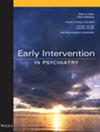Formal Thought Disorder in Individuals at Ultra-High Risk for Psychosis: Factor Structure and Associations With Cognitive and Global Functioning
Abstract
Aim
Formal thought disorder (FTD) reflects an impairment in the organisation, goal-directedness, and logical flow of thinking. It is a core feature of psychosis spectrum disorders encountered in patients ranging from early psychosis to chronic schizophrenia. However, less is known about individuals at ultra-high risk (UHR) for psychosis. This study aimed to examine the frequency and factor structure of FTD in UHR individuals and explore its associations with clinical characteristics.
Methods
FTD was assessed in 122 UHR individuals using relevant items from the Scale for the Assessment of Negative Symptoms and the Scale for the Assessment of Positive Symptoms. We used exploratory factor analysis (EFA) using principal axis factoring to identify factor structures. Associations with clinical characteristics were investigated using two-group comparisons, correlations, and multivariable linear regression models.
Results
EFA revealed a three-factor structure—disorganisation, incoherence, and poverty—accounting for 48.50% of the variance. Only the poverty factor was negatively associated with attention composite scores (β = −0.229; p = 0.040) after correcting for age and education. Total FTD and poverty factor scores were negatively correlated with GAF (r = −0.340 and r = −0.343, respectively; p < 0.001). The ones who had impaired role functioning during the past month at admission had higher scores on the total FTD (U = 878.0; p < 0.001) as well as the poverty factor (U = 1166.0; p = 0.011).
Conclusions
Our findings indicated that FTD in UHR individuals exhibits a three-factor structure, with the poverty factor significantly linked to global and cognitive functioning.


 求助内容:
求助内容: 应助结果提醒方式:
应助结果提醒方式:


